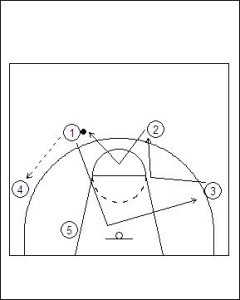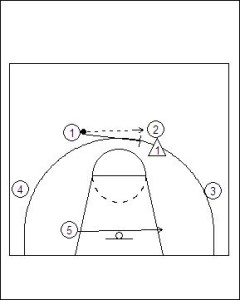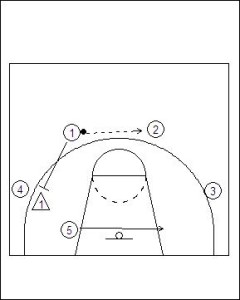4–1 Free Motion Offense
Motion Offense is one of the more preferred offensive systems available to coaches for teaching the basic building blocks of team basketball. The tactical advantages of motion offense revolve around plays based upon ‘reads’ rather than having a predetermined pattern to follow. This allows players to develop a greater understanding and respect for the team tactics of basketball.
The tactical elements discussed within this version of a motion offense are:
- Pass, Cut and Replace
- Pass and Set an On-Ball Screen
- Pass and Screen Away
- Screen Out of the Post
Each of these tactical elements can be incorporated into a team’s half court motion offense or only some of the options utilised at any one time. For example, the tactical elements of Pass, Cut and Replace can also be partnered with Pass and Screen Away. The ‘read’ affecting this tactical change-up might be on a Guard to Forward Pass (pass down the sideline) the Pass and Screen Away tactic is performed and all others passes trigger the Pass, Cut and Replace movement.
Motion offense as a strategy when utilised fully can make for a difficult time by opposition teams to scout and be prepared for. However to be truly effective a motion offense a team must be well rehearsed and plenty of opportunity provided in training for teams to perfect elements like spacing, tempo and overall execution.

Players set themselves in a four out and one in starting position.
Pass, cut and replace is the first sequence that can be used within this offence.
One (1) passes the ball and then cuts to the basket. This is what is termed a Guard to Forward pass (One to Four).
Two (2) and Three (3) rotate to replace the position in front of them that are free after the initial basket cut. Players move to get a foot inside the paint before moving to fill a position. This is to make each player an offensive threat to the defence.
One (1) after reaching the basket moves away from the ball into the open position.
If a wing player (Four or Three) back cuts they get a foot in the paint then replace themselves.

Variation: Pass and set on-ball screen
One (1) passes the ball and sets an on-ball screen for the receiver.
The post player (5) must rotate to the low post, which is on the strong side of the court.
The ball handler can proceed to use the screen to get free.
Once the screen is used One (1) will replace the ball handler and Two (2) would replace the screener’s original position.
A variation to this sequence could be that the on-ball screen is only utilised on a Guard to Forward pass (One to Four or Two to Three).

Variation: Pass and screen away
One (1) passes the ball and sets an off-ball screen away for the receiver.
The post player (5) must rotate to the low post, which is on the strong side of the court.
The player being screen for can use the screen to get free.
Once the screen is used One (1) will replace the player screened and Four (4) would replace the screeners original position.

Variation: Screen out of post
From the post position Five (5) is able to screen (on-ball and off-ball) for any of the perimeter players.
The perimeter players can use the screen to make a move to the basket.
The post player (5) then replaces the perimeter player’s position. Instead of having the Five (5) move to the perimeter a re-screen (through a down screen) can occur for the basket cutter to exit again and Five (5) will again be on the interior.
The perimeter player then replaces the post player.
The post player can only rotate to the perimeter on a screen.








Leave a Reply